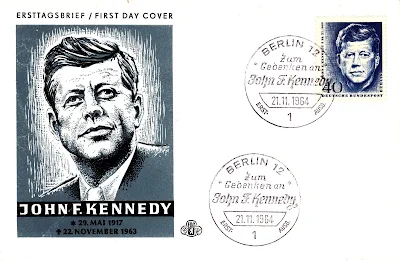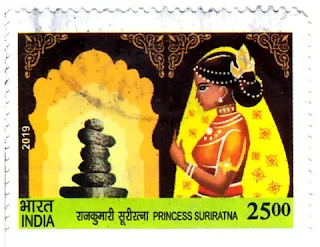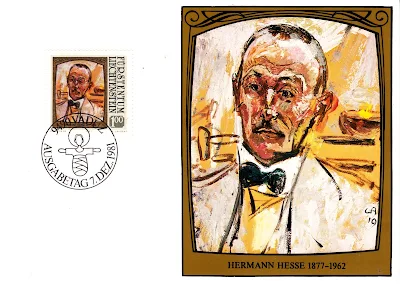LA POSTE FRANCE in 2002 issued a set of six first day cover stamps called "Etoiles du Jazz", dedicated to six jazz musicians, among them being Louis Armstrong, Sidney Bechet, Duke Ellington, Ella Fitzgerald, Stéphane Grappelli and Michel Petrucciani. Shown is a very large envelope with block set sheet and cachet of these jazz musicians.
Louis Armstrong - Born 4 August 1901 in New Orleans, he learned the cornet in a home for abandoned children, worked from 1914 with various local glories, including King Oliver and the trombonist Kid Ory, then aboard paddle steamers on the Mississippi River. After having accompanied blues singers with whom he made his phonographic debut, he formed his Hot Five (1925) then Hot Seven with which he signed the first recorded masterpieces in the history of jazz. According to the great orchestras, films, tours and festivals, encounters (with Sidney Bechet, Ella Fitzgerald, Duke Ellington, Frank Sinatra, etc.), his power of melodic invention, his mastery and his instrumental power, his rugged voice, his humor impose him as one of the first "stars" of jazz.
Sidney Bechet - “Creole” from New Orleans (where he was born on 14 May 1897), Sidney Joseph Bechet took part in tours that took him to Europe from 1919, within the Will Marion Cook's Southern Syncopated Orchestra, and in 1925 with Joséphine Baker and the Negro Revue. After a series of recordings, notably with the pianist Jelly Roll Morton (1939) and Louis Armstrong (1940), he was one of the stars, in 1949, of a Parisian jazz festival. Installed in France the following year, he made himself known there, on the clarinet, as one of the most popular artists, putting his flamboyant lyricism at the service of songs without denying the New Orleans tradition or the blues. His Petite Fleuret other Onions would become the hymns of his Parisian funeral.
Duke Ellington - Pianist and conductor, Edward Kennedy "Duke" Ellington, born in Washington on 29 April 1899, was the first full "jazz composer". From 1926, under his direction, soloists followed one another corresponding to “periods” of his work: “jungle” with the trumpeters Bubber Miley then Cootie Williams and the voice of Adelaide Hall, and soon these pillars that would become the saxophonists Johnny Hodges and Harry Carney, while the composer-arranger-pianist Billy Strayhorn was with him until his death in 1967 as a double for Duke. Exoticism, impressionism, almost symphonic compositions, stage and film music, sacred concerts: Ellington has used all forms and musical means to tell the story of his people and to please all the peoples of the world
Ella Fitzgerald - Born sixteen years earlier in Virginia, Ella Fitzgerald won at the Opera House in Harlem, in 1934, the first prize in a singing competition reserved for amateurs. The drummer Chick Webb immediately engaged her to perform in his orchestra. When he died in 1939, she took over the management and kept it until 1942. She then acquired a reputation that went far beyond the borders of jazz, establishing herself as the most brilliant of melodic invention. From Louis Armstrong to Duke Ellington via Count Basie, she associated her voice and her improvisational verve with the greatest jazzmen, and that until the last years of her life. She died in Beverly Hills on 15 June 1996.
Stéphane Grappelli - Born 26 January 1908, the self-taught Stéphane Grappelli received his first violin at the age of twelve and started playing in the courts. In 1934 he formed the Quintet of the Hot Club de France with Django Reinhardt. The two musicians were separated by war in 1939 and then by the death of Reinhardt in 1953. Stéphane Grappelli established himself as a genius of improvisation whose virtuosity erased the boundaries between styles and musical genres. From Yehudi Menuhin to Michel Petrucciani, from Martial Solal to Michel Legrand, from Joe Venuti to Didier Lockwood, he played with countless musicians until his death on 1 December 1997.
Michel Petrucciani - Born in Orange on 28 December 1962, weakened by osteogenesis imperfecta, Michel Petrucciani studied classical piano, then, having discovered jazz, performed with his father, guitarist, and his brother Louis, double bass player. Inaugurated with a first record in 1980, the list of his recordings and partners on both sides of the Atlantic - from Stéphane Grappelli to saxophonists Lee Konitz, Wayne Shorter and, for five years, Charles Lloyd - testifies to the enthusiasm he aroused in less than two decades. When he died, on 6 January 1999 in a New York hospital, he joined the legendary ranks of illustrious jazz men and women.



























